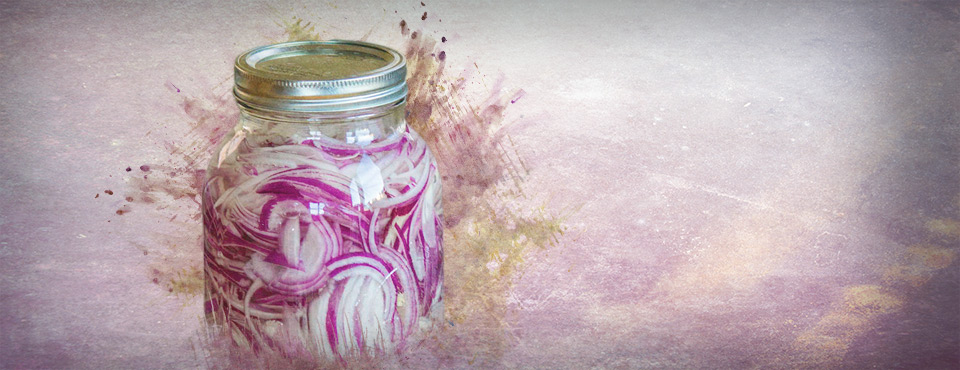I really can’t stand the taste of raw onions and I especially loathe the lingering taste in my mouth that lasts for hours (and the smell of someone else’s onion breath is even worse). But I love the taste of cooked onions. And more important, I like onions in kimchi and fermented coleslaw. So I figured it might be worth a try to ferment onions independently.
There really isn’t much to fermenting onions the way I did it. First, I chose red onions because I figured the taste might be influenced by a welcoming reddish-pink hue and I wanted to give these close to raw onion cousins as much of a fighting chance with my taste buds as possible.
I sliced the onions rather large although I’m sure it would work the same if they were diced. I hoped to use these onions raw for salads and cooked for other random dishes so I decided the larger the more versatile.
I added the onions to a half gallon mason jar and topped them with a salt brine of 2.25% salt to water ratio. I left the onions on my kitchen counter under a a cloth napkin to protect the ferment from direct sunlight. The onions bubbled profusely and I had to release the CO2 multiple times during 1.5 week fermentation process.
In the end, these fermented onions were submerged in a beautiful pink brine and ready for refrigeration and eating.
Step-by-Step Onion Fermentation Instructions
This recipe will make one half gallon of fermented onions.
Supplies:
- 4 large red onions chopped or diced
- 42 grams salt (3 tablespoons)
- 60 ounces water (nearly half gallon)
- 64 ounce mason jar (or two 32 ounce jars)
Directions:
- Stuff red onions into empty mason jar
- Mix salt and water in separate jar or bowl
- Pour salt water brine into jar until onions are submerged
- Screw on jar lid
- Put jar in dark place at room temperature
- Release C02 buildup in jar daily
- Refrigerate after 1 to 2 weeks
Note: You may not use all of the salt brine. You can either use it for another fermented recipe or save it because you might need it to keep the onions covered (the brine sprays out when opening the jar if you forget to release C02 buildup for a few days).
The Results
Do fermented onions taste different than raw onions? Yes. Fermentation tames them.
The first thing I noticed after opening the jar was that the aroma was sweet with only a mild hint of raw onion. My wife was turned off by her initial whiff but she is also biased as a repeat raw onion breath offender.
Risking fowl breath for the rest of the day, I popped a couple slices of onion in my mouth only to be surprised by the transformation. My first impression was similar to the aroma; sweet with a hint of raw onion.
I should emphasize that I like the smell of freshly chopped raw onion and I like the taste of cooked onion. But again, I do not like the taste of unadulterated onion. However, this is a melding of the best of both worlds. These fermented onions are sweeter as if cooked and only retain a slight pungency that is quite enjoyable. They remain crisp and crunchy too.
I will finally be able to enjoy onions in a salad and on a freshly grilled hamburger. It is slightly disappointing that it is the middle of winter and not really the season for such meals. But these onions will last into next winter if I don’t eat them all before that so there will be plenty of time for onion flavor enhancing experiments.
If stored in the refrigerator, your fermented onions should last anywhere from 6 months to 1 year.
What about onion breath?
I haven’t subjected anyone to smelling my breath, but I can say that the lingering aftertaste in my mouth is no where near as strong. There is still an aftertaste but I can eat a spoonful or two of these fermented onions without being disgusted. This is a huge breakthrough and my only hope is that this is not a gateway onion that converts me into a raw onion eater and bad breath breather.
Ferment these onions at your own risk; you might convert too.


 Listen Now
Listen Now 
